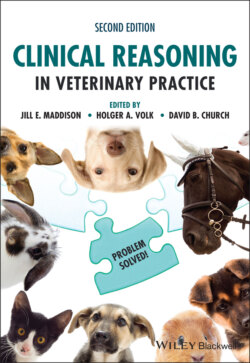Читать книгу Clinical Reasoning in Veterinary Practice - Группа авторов - Страница 4
List of Illustrations
Оглавление1 Chapter 1Figure 1.1 Visual representation of the staircase of memorisation.Figure 1.2 Introducing a diagram into the sequence of actions to improve und...Figure 1.3 How the structure of the chapters leads to understanding and memo...Figure 1.4 Memorisation benefit through subvocalisation.Figure 1.5 Benefits of having a learning buddy.
2 Chapter 2Figure 2.1 Skill acquisition pathway. (This pathway can apply to the acquisi...Figure 2.2 Clinical reasoning step‐by‐step.Figure 2.3 Clinical reasoning step‐by‐step: define and refine the problem.Figure 2.4 Clinical reasoning step‐by‐step: define and refine the system.Figure 2.5 Clinical reasoning step‐by‐step: define the location.Figure 2.6 Clinical reasoning step‐by‐step: define the lesion.Figure 2.7 Clinical reasoning step‐by‐step: recap.
3 Chapter 3Figure 3.1 The relationship between the elements of the emetic reflex.
4 Chapter 7Figure 7.1 The five‐finger rule.
5 Chapter 8Figure 8.1 The combination of clinical signs determines the location of the ...Figure 8.2 The five‐finger rule.Figure 8.3 The onset and clinical course of a disease can narrow down aetiol...Figure 8.4 Intra‐cranial causes for epileptic seizures.Figure 8.5 Extra‐cranial causes for (reactive) seizure.Figure 8.6 Flowchart to help define the lesion.Figure 8.7 Algorithm for peripheral vestibular work‐up.
6 Chapter 10Figure 10.1 Blood smear from a dog showing reticulocytes. New methylene blue...Figure 10.2 A blood smear from a dog with immune‐mediated haemolytic anaemia...Figure 10.3 Blood smear from a dog with schistocytes and acanthocytes indica...
7 Chapter 11Figure 11.1 Bilirubin metabolism.
8 Chapter 12Figure 12.1 Very simplified overview of the process leading to the formation...
9 Chapter 14Figure 14.1 Factors to be considered for refining the problem in patients wi...Figure 14.2 Clinical deficits to help differentiate between musculoskeletal ...Figure 14.3 Diagnostic work‐up for the musculoskeletal system.Figure 14.4 Neuroanatomical localisations. SCS, spinal cord segments.
10 Chapter 15Figure 15.1 Flow diagram to the diagnostic approach of pruritus in companion...Figure 15.2 Flow diagram to the diagnostic approach of scaling presentation ...Figure 15.3 Flowchart outlining the diagnostic approach to canine otitis.
11 Chapter 19Figure 19.1 The main influences on professional reasoning and decision‐makin...
